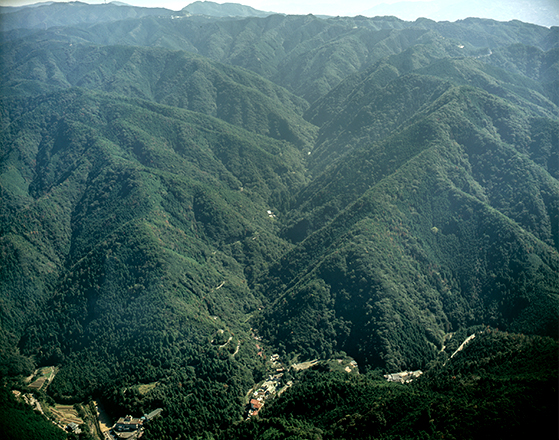Mt. Inunaki
Since ancient times, the temple has been enshrined as a sacred place for Katsuragi Shugendo and inherited ritual events.

Mt. Inunaki (or Inunakisan) is home to Shipporyuji Temple; the temple was founded in 661 by En-no-Gyoja, the founder of Shugendo (an original religion in Japan that incorporated primitive mountain worship into Buddhism), when he was 28 as a temple for Katsuragi Shugen. It is located in the mountains of Iriyamada Village’s Funabuchi Village, and its sango (honorific mountain name) is Inunakisan, which is the name of the location. The temple’s name, “Shipporyu,” derives from the shipporyu (seven treasure waterfalls) in the mountain. The temple was restored by Shiichi Shonin, Hashimoto Masataka of the Southern Court and others in the Southern and Northern Courts period (1336-1392). During the Warring States period (1467-1573), a priest of Negoroji Temple became the betto (acting head priest) of Shipporyuji Temple in order to place it under the control of Negoroji Temple. While staying in Hinenosho in November 1502, Kujo Masamoto borrowed Shipporyuji Engi from Shinkai, the betto of Shinpukuin Temple at that time, and transcribed it. That copy was passed down in the Kujo Family, and the origin of the temple can be learned from it. According to the text, En-no-Gyoja saw Fudo Myoo (Acala, one of the Five Wisdom Kings) rise on a rock in a waterfall deep in a mountain and shed tears of joy. He then opened up the wasteland on the mountain peak, erected a sodo (a thatched hut) and carved an image of the rising of Fudo Myoo, which he made the principal image. The text also shows that there were seven waterfalls on the mountain and that the name of the temple was derived from the water being chisui (water of wisdom that washes away worldly desires) with seven treasures.
While Shipporyuji Temple was a branch of Negoroji Temple (a branch of Shogoin Temple) and priests of the Tendai sect accordingly controlled the temple, it is currently the head temple of the Inunaki school of the Shingon sect. The Masamoto-ko Tabihikitsuke mentions the names Inunakisan and Shipporyuji Temple, as well as its sub-temples (priest’s houses), including Amidabo, Nishinobo and Musashibo. Masamoto recorded that he fled to Nishinobo when the troops of Sato Hisanobu, who was a hikan (bureaucrat) of the shugo (regional administrator) of lower Izumi, attacked Kaminogo, Hineno Nishikata and Tsuchimaru in August 1502 and that the priests of Inunakisan offered prayers for rain at Hibashiri Jinja Shrine and other places. Inunakisan was founded six years before Ominesan (Mt. Omine) in Yamato and is therefore called “Motosanjo” (original mountain top). It is also called “Okunoin” of “Katsuragi Mineju” and is listed as the eighth training ground in Inunakisan Engi in 1502. The temple grounds contain a stone tablet dated 1459.
“This mountain also has an interesting legend. In the Tentoku period (957-960), a hunter named Yamada who lived in Kishu Ikedanosho was hunting for deer on Mt. Katsuragi. While taking aim to launch an arrow at a deer, his dog barked, and the deer ran away. The hunter got angry and cut off the dog’s head. Then, the head leaped up and bit a massive snake that was about to kill him. So that he could hold a memorial service for the dog that saved his life, the hunter became a priest and prayed for the repose of the dog’s soul for a long time. It is said that Emperor Uda heard the story and praised the loyalty of the dog, naming the mountain Inunaki (dog’s barking).” (Source: the website of Inunakisan Shipporyuji Temple)






